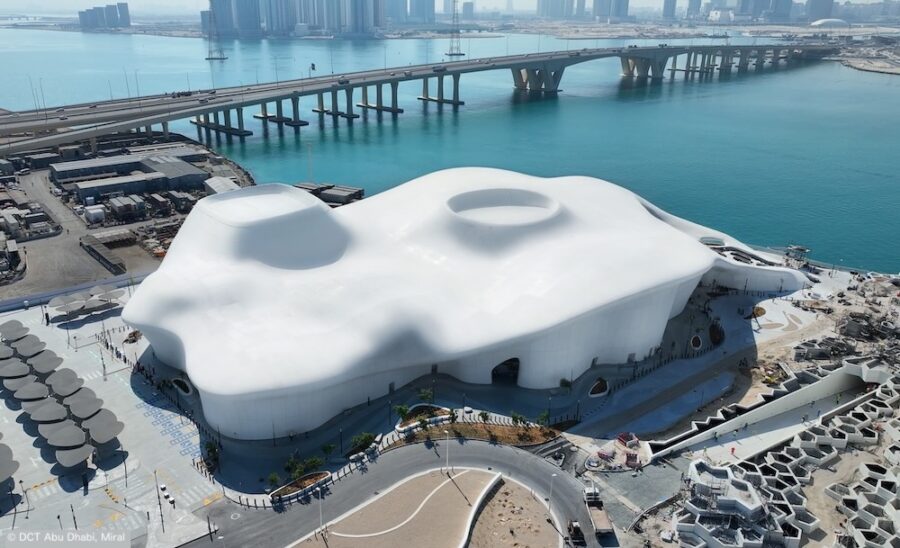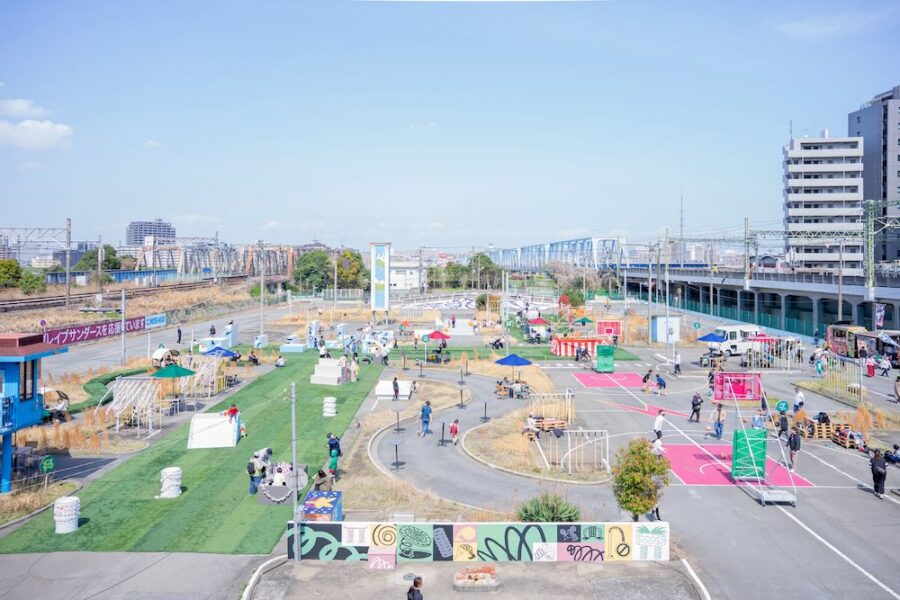
CULTURE

10 Reasons to Visit the 〈House of Hungarian Music〉 designed by Sou Fujimoto in Hungary
藤本壮介がハンガリーに設計した〈House of Hungarian Music〉を訪れるべき10の理由
#Liget Budapest「Liget Budapest – Megbújik a Városliget fái között a Magyar Zene Háza különleges épülete」(2021/08/24)
2021年、世界で最も期待されている建築物の1つと言われる、ブダペストに建設中の〈House of Hungarian Music〉が、今年末にオープンします。
日本のスター建築家である藤本壮介が設計したこの建物は、ヨーロッパで最大の文化的都市開発であり、リゲ・ブダペスト・プロジェクト(Liget Budapest Project, ブダペスト最大かつ最も象徴的な公共公園のリニューアルプロジェクト)の一環として、ハンガリーの首都に建設されています。
〈House of Hungarian Music〉は、現代の鮮やかなランドマークとなる建物です。巨大なガラス壁と、穴の開いた有機的に起伏する屋根構造によって、他に類を見ない壮大な光景を生み出します。
型破りなデザインのこの建物には、さまざまなイベントや音楽体験を提供する複合施設が入っています。
年末のオープンを前に、現代建築と音楽が好きな人にとって、ハンガリーを訪れるべき10の理由を紹介します。
① ブダペストの現代建築のランドマークだから
〈House of Hungarian Music〉は、ハンガリーの首都に、現在のハンガリーにはない象徴的な現代建築物をもたらし、さらに国際的に高い評価を受けている建築家によって設計されます。藤本壮介氏のデザインは、匿名のコンペで168のプロジェクトの中から選ばれました。
藤本壮介のデザインは、匿名のコンペで168作品の中でも特に刺激的で、国際的な審査員によって優れていると評価され、選ばれました。
この建物には、藤本氏の特徴がよく表れています。その中でも、建築と自然環境の間の境界を取り除くために、コントラストに基づいた建築の概念が最も印象的です。
② 国際的な評価を受けた建物だから
完成は2021年末の予定ですが、2014年に国際設計競技が発表されて以来、〈House of Hungarian Music〉は世界中から注目を集めています。
それを象徴するのが、完成前にもかかわらず権威ある賞を受賞していることです。CNNやWAC(World Architecture Community)では、2021年に最も期待される公共建築の1つに選ばれています。
International Property AwardsとMusic Cities Awardsでは最優秀建築に選ばれ、後者ではそのユニークなコンセプトが評価され、「Best Use of Music in Property Development(施設開発における音楽のベストな使い方)」のタイトルを獲得しました。

③ 気候変動に配慮したサステナブルな建物だから
〈House of Hungarian Music〉の設計、施工にあたり、現代の最大の課題の1つである気候変動に対応した、持続可能なソリューションの使用に特に注意が払われました。
この建物のエネルギー供給の大部分は再生可能エネルギーで賄われており、地熱エネルギー取得のため120台のヒートポンプが100mの深さに設置されています。
また、経済的で非常に革新的なソリューションとして、近隣のアイススケートリンクであるシティパーク・アイスリンクの、夏の余剰エネルギーを利用した遠隔地冷房を採用しました。
環境への配慮という点において、〈House of Hungarian Music〉の建設、施工は、国際的に認められた建築物持続可能性評価システムであるBREEAMによって「模範的」と評価されました。
④ 世界初の音楽教育機関である三分割構造の建築だから
〈House of Hungarian Music〉の他に類を見ないデザインは、ユニークな内部構造と相まっています。
この施設の複雑な音楽的コンセプトと多様なイベントは、建物の三分割構造にも現れています。
地下階には、常設展示と仮設展示のほか、ユニークなサウンドドームが設置されます。この階は自然光が入らないため、一般的な建築コンセプトとは異なり、一種の夢の世界、体験の領域のように機能しています。
公園のレベルは、コンサートホールや野外ステージでの音楽ライブや、湖畔の庭園でのレクリエーションなど、舞台芸術のために設けられています。
2階はより深い学習と教育のため、明るく明確にレイアウトされたスペースを提供します。この階にはデジタルアーカイブが格納され、おもにハンガリーのライトミュージックのドキュメント、マルチメディアライブラリ、クラブが公開されており、音楽教育室では、若者を待ち受ける複雑な体験に備えることができる、舞台芸術に割り当てられたフロアです。
#Magyar Zene Háza「Sou Fujimoto House of Hungarian Music video」(2018/08/22)
⑤ ハンガリー音楽の歴史を学べる常設展があるから
インタラクティブな要素を盛り込んだ魅力的で包括的な常設展示では、〈House of Hungarian Music〉の訪問者にヨーロッパの音楽、特にハンガリーの音楽の歴史が紹介し、別のスペースでは臨時展示が行われます。
この展示では、何世紀にもわたる音楽の歴史を、7つの重要なターニングポイントごとに分けて紹介しています。この時間の旅は、音楽の誕生から始まり、ハンガリー音楽の起源である民族音楽の領域へと誘うものです。ここから、楽譜やポリフォニーの発展、オペラの成立、楽譜の印刷、ヨーロッパの都市や宮廷での音楽のネットワークなどを辿ることができます。
また、偉大な作曲家に親しみ、バルトークやコダーイの最も重要なアイデアや作品に触れ、20世紀のアバンギャルドの音楽的実験に参加し、蓄音機からクラウドまでのサウンドテクノロジーの革命を追うことができますが、これらすべての中心にあるのは、人々とコミュニティ、そして音楽の制作、鑑賞、意味です。
革新的なソリューションには事欠きません。インタラクティブなゲームや多くの体験は、現在の最先端技術を用いて、若い人たちに過去を生き生きと伝えます。
⑥ 音楽教育とポピュラーサイエンスのプログラムがあるから
今や誰もがあらゆる音楽に簡単にアクセスできる時代ですが、この音楽の迷宮の中を進むのは困難です。
〈House of Hungarian Music〉では、音楽の美しさや魅力を紹介しています。
子供も大人も、音楽の本質をより深く理解することができます。
例えば、オープンスクール形式のプログラムやワークショップでは、クラシックから電子音楽まで、さまざまなジャンルの音楽について学ぶことができます。
この施設では、事前に教材を用意するなどして学校団体をサポートし、音楽教師の助けを借りてハウス内の音楽の世界を紹介したり、さまざまなテーマのワークショップで指導したりします。

⑦ サウンドドームを体験できるから
世界的にも珍しい〈House of Hungarian Music〉の魅力の1つとして、オーディオファンにはたまらない「サウンドドーム」があります。
半球状のドームの中では、たくさんのラウドスピーカーからあらゆる方向に向かって音が放出され、素晴らしいサウンド・インスタレーションを体験することができます。
半球状のドームに取り付けられたスクリーンによって、音への没入感が視覚的にも高められます。
日中は、常設展示に加えて、カルパチア盆地の音をもとに構成されたサウンド・インスタレーションに深く入り込むことができ、夜は上映に加えてDJセットの会場となり、小規模なコンサートも開催されます。
⑧ ライブラリーとクラブがあるから
〈House of Hungarian Music〉のライトミュージックとリサーチセンターのライブラリは、データベースおよび情報センターとなり、ハンガリーや国際的なポピュラーミュージックの歴史に関する最も重要な書面、音声、画像、および動画のドキュメントがデジタル形式で提供されます。
⑨ 音の波をイメージした屋根構造だから
〈House of Hungarian Music〉の象徴的な特徴の1つは、音の振動、音波を視覚的なイメージに基づいてデザインした、有機的で「浮いている」屋根構造です。
屋根には実質的に2つの平行な要素や直角はなく、すべてが個性的です。
屋根表面の約100個の光井戸(ライトウェル)により、自然光を建物の各階に導くことで、内部空間を照らし出し、特別な雰囲気をつくり出しています。

⑩ 葉っぱの天井を持つガラスの宮殿だから
藤本壮介のビジョンは、〈House of Hungarian Music〉と都市公園との境界の解消です。
建物の中に入ると、まるで自然の中を歩いているかのような錯覚に陥ります。
高さ12mにもおよぶ94枚のパネルで構成された巨大なガラスのファサードが、この建物に空気感と透明感を与えています。
建物と自然との調和は、吊り天井に設置された建築要素によってさらに強調されています。この建築要素は、ブダペストにある有名なリスト・アカデミーの大ホールの天井からインスピレーションを得たもので、千枚以上の葉をモチーフにした模様は、光の変化によって常に色が変化しています。
より大きな全体の一部として
〈House of Hungarian Music〉は、リゲ・ブダペスト・プロジェクトの一環として、ヨーロッパの歴史上最初期の公共公園の1つである市営公園内に建設される、ヨーロッパ最大の文化的都市開発プロジェクトです。
公園内には、ブダペストで最も利用されている文化施設や、コミュニティやレクリエーションの場である、美術館、クンストハレ、セーチェーニ浴場、ヴァジュダフニヤド城、アイスリンク、市立動物園などがあり、毎年数百万人の人々が訪れています。
リゲ・ブダペスト・プロジェクトは、この豊かな伝統を継承し、かつて市営公園の目障りだった老朽化した建物やコンクリートで固められた駐車場のスペースに、新たな文化施設を設立します。
新しい施設は、100年以上前からここにある施設と同様に、ブダペストだけでなく、国全体の誇りとなるでしょう。
市立公園の伝統を守りつつ、21世紀の技術を取り入れた「リゲ・ブダペスト・プロジェクト」が本格的に始動すると、ハンガリーの文化的景観に国際的な魅力を持つ新しいアトラクションが加わることになります。
Ten reasons why it will be worth visiting the House of Hungarian Music
Regarded as being among the most anticipated buildings in the world in 2021, the House of Hungarian Music, now under construction in Budapest, will open its gates at the end of this year. The building, designed by the Japanese star architect, Sou Fujimoto, is the biggest cultural urban development in Europe, and is being constructed in the Hungarian capital as part of the Liget Budapest Project. The house will be a true contemporary landmark building: it will be a spectacular sight unlike any other with its enormous glass walls and organically undulating roof structure punctured with holes. The building with a truly unconventional design houses a complex institution of musical initiation welcoming visitors with a wide range of events and musical experiences. Before its opening at the end of the year, we will share ten reasons why it will be worth visiting Hungary for those who appreciate contemporary architecture and music.
A contemporary architectural landmark in Budapest
With the House of Hungarian Music the Hungarian capital will be enriched with an iconic contemporary building, which the city presently lacks, and moreover is designed by an internationally acclaimed architect. Sou Fujimoto’s design was selected from among 168 projects in an anonymous competition. His design was particularly exciting and deemed outstanding by the international jury. The building itself bears Fujimoto’s compelling signature, the most striking aspect of this being his notion of architecture based on contrasts to lift the boundaries between the built-up and the natural environment.
International recognition
The building will only be completed at the end of 2021 but ever since the announcement of the international design competition in 2014, the House of Hungarian Music has attracted attention from all over the world. Nothing serves as a better example of this than it having been awarded prestigious recognitions even before its completion: CNN and the World Architecture Community (WAC) declared it one of 2021’s most eagerly-awaited public buildings. The International Property Awards and the Music Cities Awards selected it as the best building, and thanks to its unique concept during the latter competition awarded it the title of Best Use of Music in Property Development.
A climate-friendly and sustainable building
During the design and implementation of the House of Hungarian Music special attention was paid to the use of sustainable and climate-friendly solutions in response to one of the greatest challenges of today. For precisely this reason the greater part of the energy provision for the house will come from renewable energy sources, and 120 heat pumps were installed 100 metres deep to provide geothermal energy. Another economical and extraordinarily innovative solution was to cool the building with distance cooling, which will be supplied by the excess summer energy capacity of the nearby City Park Ice Rink. In respect to environmental awareness, the construction and implementation work of the House of Hungarian Music was given an ‘exemplary’ rating by BREEAM, the internationally recognised building sustainability assessment system.
A house with a tri-partite structure – the world’s first institution of musical initiation
The extraordinary design of the House of Hungarian Music is coupled with a unique interior structure. The complex musical concept and diverse events of the facility are also manifest in the tri-partite structure of the building. The spaces below ground level will house the permanent and temporary exhibitions as well as a unique sound dome. This level, which is deliberately closed to natural light – since the building is otherwise transparent both inside and out – is distinct from its general architectural concept and functions like a kind of dream world, a realm of experience. The park level is designated for the performing arts with live music events in the concert halls and the open-air stage, as well as recreation in the garden next to the lake. The second floor offers bright and clearly laid-out spaces for deeper study and education: this level will house the digital archive, principally making available the documents of Hungarian light music to the public, as well as the multimedia library and club, while in the music education rooms young people will be prepared for the complex experience that will await them on the levels assigned to the performing arts.
The permanent exhibition
A fascinating and comprehensive permanent exhibition with interactive elements will present the history of European, and more especially Hungarian music, to the visitors to the House of Hungarian Music, while a separate space is devoted to temporary shows. The exhibition guides visitors through the history of music over the centuries divided into sections by seven highlighted turning points: this journey through time begins with the magic of the birth of music and takes visitors into the realm of folk music, which is the cradle of Hungarian music. From here, visitors can follow the development of sheet music and polyphony, the establishment of opera, the printing of sheet music and the network of music in the cities and courts of Europe. They can familiarise themselves with the greatest musical composers, tarry amidst the most significant ideas and works of Bartók and Kodály, take part in the musical experiments of the 20th-century Avant-Garde and of course follow the revolution in sound technology ranging from the phonograph to the cloud but at the centre of all this are people and community as well as the making, appreciation and meaning of music. There will be no shortage of innovative solutions: the interactive games and plethora of experiences will bring the past alive for young people using the most cutting-edge technology of the present.
Music education and popular science
Nowadays everyone can easily access any kind of music but it is difficult to navigate in this veritable musical labyrinth. The House of Hungarian Music shows what lends music its beauty and appeal. Children and adults alike can gain a greater understanding of the essence of music. For example, they can learn about the various musical genres at open school type programmes and workshops on a musical palette ranging from classical to electronic music. The institution will assist school groups by preparing educational material sent to them prior to their visit, among other initiatives, while they will be introduced and guided through the world of music in the House with the help of music teachers and at workshops with various themes.
The sound dome
One of the special attractions of the House of Hungarian Music – regarded as a rarity all over the world – will be the sound dome, which is sure to become a favourite with audiophile visitors. In the hemispherical dome sounds will be emitted from a plethora of loudspeakers from every direction, providing the opportunity to create amazing sound installations. This immersion into sound will be visually enhanced by a projection screen attached to the semi-sphere. During the day, complementing the permanent exhibition, visitors can take a deep dive into a sound installation composed based on the sounds of the Carpathian Basin, while in the evenings the dome will be a venue for DJ sets supplemented with screenings and it will also host smaller-scale concerts.
Library and club
The House of Hungarian Music’s library of light music and research centre will be a database and information centre where the most important written, sound, picture and moving picture documentation of the history of Hungarian and international popular music will be made available in digital form to researchers and enthusiasts in one place for the first time.
A roof structure inspired by soundwaves
One of the most iconic features of the House of Hungarian Music is its organically ‘floating’ roof structure designed based on the visual image of the vibration of sound: the soundwave. There are virtually no two parallel elements and no right angles in the roof – everything is unique. The roof’s surface is punctured by close to one hundred custom-designed wells of light, which channel natural light through the building’s levels, thus helping to illuminate the interior spaces and create a special atmosphere.
A glass palace with a leafy ceiling
Sou Fujimoto’s vision dissolves the boundaries between the House of Hungarian Music and the City Park. Upon entering the building, visitors feel as if they are still walking in a natural environment. The building is lent this airiness and transparency by the enormous glass façade constructed using exactly 94 panels, all of which were individually manufactured and in some places reaching twelve metres in height. The harmonious blending together of the building with nature is further enhanced by an architectural element installed into the suspended ceiling, which is inspired by the ceiling of the famous Great Hall of the Liszt Academy in Budapest with a pattern featuring more than one thousand leaves and its colours constantly changing depending on the changes in light.
Part of a bigger whole
The House of Hungarian Music is the biggest cultural urban development project in Europe being built as part of the Liget Budapest Project in the City Park, one of the first public parks in Europe’s history. Located in the park are Budapest’s most frequented cultural institutions as well as community and recreational venues: the Museum of Fine Arts, the Kunsthalle, the Széchenyi Baths, the Vajdahunyad Castle, the Ice Rink and the Municipal Zoo, which attract millions of visitors every year. The Liget Budapest Project is continuing this rich tradition by establishing new cultural institutions in the spaces once occupied by dilapidated buildings and concreted-over car parks that were eyesores in the City Park. The new institutions, similarly to those that have been here for over a century, will make not only Budapest but the entire country proud. Following the full implementation of the Liget Budapest Project, which builds upon 21st-century techniques while still adhering to the City Park’s own traditions, the City Park will add a new attraction with an international appeal to Hungary’s cultural landscape.









